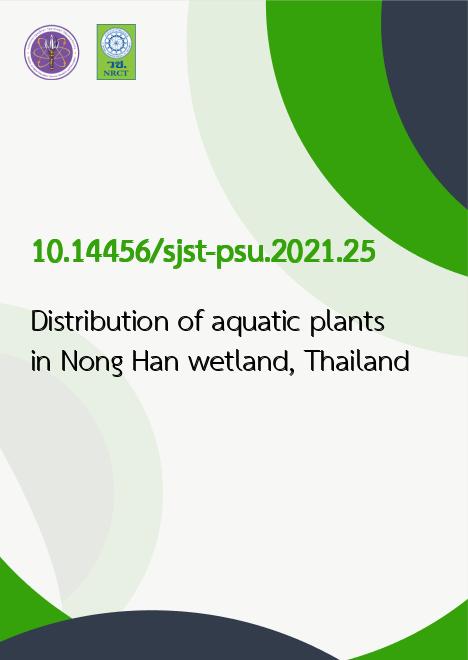
|
Distribution of aquatic plants in Nong Han wetland, Thailand |
|---|---|
| รหัสดีโอไอ | |
| Creator | 1. Somsak Rayan 2. Saifon Kaewdonree 3. Amornrat Rangsiwiwat 4. Boontiwa Chartchumni |
| Title | Distribution of aquatic plants in Nong Han wetland, Thailand |
| Publisher | Research and Development Office, Prince of Songkla University |
| Publication Year | 2564 |
| Journal Title | Songklanakarin Journal of Science and Technology (SJST) |
| Journal Vol. | 43 |
| Journal No. | 1 |
| Page no. | 195-202 |
| Keyword | aquatic plants, biomass, distribution, Nong Han wetland |
| URL Website | https://rdo.psu.ac.th/sjstweb/index.php |
| ISSN | 0125-3395 |
| Abstract | Aquatic plants are regarded as primary producers that play a significant role in the ecosystem. Thus, the distribution ofaquatic plants has a substantial impact on aquatic organisms. The purpose of this research was to study the spatio-temporalvariation of the distribution of aquatic plants in Nong Han wetland, Thailand. According to the results, there were 31 species and22 families of aquatic plants in Nong Han wetlands with the mean biomass of 13,991.44 g m-2; where by Potamogeton malaianusMiq was the dominant species with highest biomass. In addition, the central wetland to the east had the highest amount biomass,and the period between February and April had the greatest influence on the biomass of aquatic plants. Moreover, the mean valueof chlorophyll-a was found to be 0.021?0.014 mg l-1, indicating a high eutrophic level. Eichhornia crassipes and Salviniacucullatas were invasive species with the tendency to cause damage to the water body in the future. Accordingly, to maintainecological balance and sustainable output, stakeholders should implement preventive measures, eliminate invasive plants, andreduce the discharge of organic substances which are the source of plant nutrients into the water body. |
